The insider’s guide to fine wine trends, and the most compelling wines to watch
Wine Lister has released its second annual Wine Leagues, celebrating some of the top-performing wines and producers in today’s new and much-diversified fine wine era. Informed by an in-depth trade survey with leading industry figures, the report provides a 360° view of those regions, producers, and wines that have seen strides in quality, popularity, economic promise, and more in 2021.
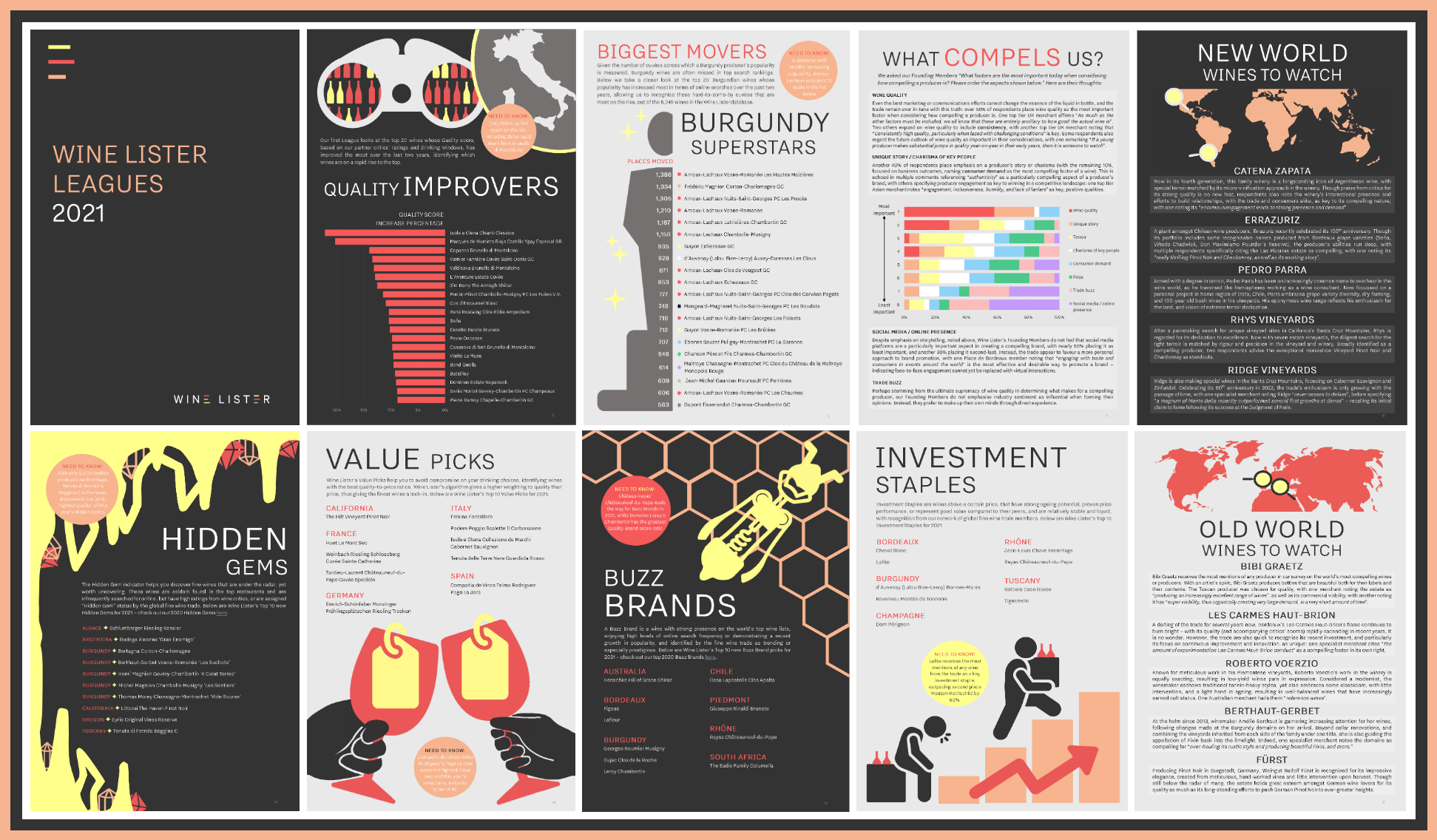
Wine Lister’s annual in-depth survey sees our expert panel of 47 CEOs, MDs, and wine department heads share their insight on some of the fine wines to have on your radar, as we ask them:
“What are the most compelling wines and producers in the market today?”
Respondents singled out 188 wines and producers collectively, that span no less than 20 major regions. Within the list, our team identifies Bibi Graetz, Les Carmes Haut-Brion, Roberto Voerzio, Berthaut-Gerbet, and Fürst as wines to watch in the Old World, whilst calling out the New World wonders of Catena Zapata, Errazuriz, Pedro Parra, Rhys Vineyards, and Ridge Vineyards.
The report also includes rankings across:
- Biggest quality improvers, which show impressive movement from Italy (occupying five places in the list of the top 20 by Quality score progression), with Isole e Olena Chianti Classico leading the pack
- Best search rank movers, wherein Bordeaux represents eight of the top 20 wines whose popularity has increased most in terms of online searches (including Smith Haut Lafitte, Domaine de Chevalier, Figeac, and Léoville Poyferré)
- Burgundy superstars, focusing on popularity movements from the trade’s darling region – Arnoux-Lachaux features 10 times in the list of top 20 Burgundian wines whose online searches have increased the most over the last two years
- Wine Lister’s top-10 recommendations per Wine Lister Indicator; Hidden Gems, Value Picks, Buzz Brands, and Investment Staples in 2021
For the full analysis, download your free copy of Wine Lister’s 2021 Leagues here.
Tales of the 2016 told by Castiglion del Bosco
One of the highest-scoring vintages in recent decades, 2016 has been described as a milestone for Montalcino and its flagship wine, Brunello. Providing the first taste of 2016 Riserva in the UK, WLPR was honoured to accompany Castiglion del Bosco through an early preview of its monumental Riserva Millecento 2016 release (set for January 2022) at London’s Enoteca Turi, joined by a handful of the city’s leading trade figures and fine wine collectors.
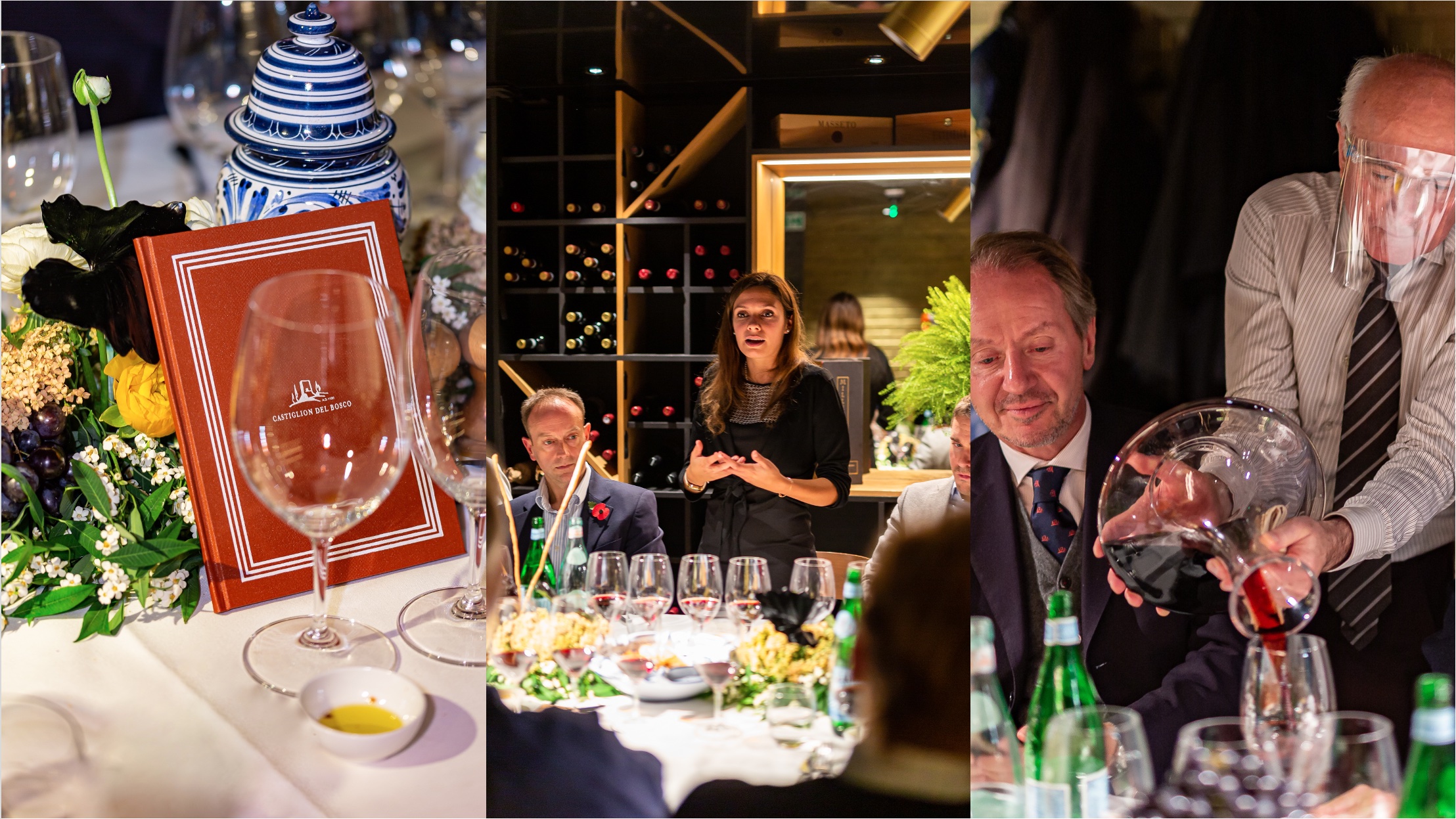 Bespoke menu (left), Castiglion del Bosco’s Marketing Manager, Gemma Grieco talking guests through the line-up (middle), Enoteca Turi owner, Giovanni Turi pouring the wines (right)
Bespoke menu (left), Castiglion del Bosco’s Marketing Manager, Gemma Grieco talking guests through the line-up (middle), Enoteca Turi owner, Giovanni Turi pouring the wines (right)
The 2016 Riserva – some of the best from Brunello?
With big shoes to fill following the release of the highly-praised 2015, the 2016 marks the second great year in a row for Brunello di Montalcino, though very different from its predecessor. Whilst the 2015 growing season was hot and dry, 2016 was slightly cooler, with greater diurnal range during the ripening season. These climatic differences result in the 2015s being more generous in both texture and body, while the successive vintage is pure and elegant, with significant ageing potential.
Having been at the property since its acquisition by Massimo Ferragamo in 2004, Castiglion del Bosco’s winemaker Cecilia Leoneschi describes the 2016 as the estate’s “best ever” Brunello. The mild summer encouraged a long, slow ripening, while good conditions at harvest allowed the estate to “harvest each vineyard at the perfect moment” – resulting in “rich wines with outstanding elegance”.
Cecilia hails the 2016 vintage of Castiglion del Bosco’s Riserva Millecento (so-named due to the property’s original construction in 1100) as having “arrived at our intention”. She refers to creating a wine that reflects the magnificence of the estate’s past, while “representing what we want our future to be”. Finally, she adds that the 2016 relays the estate’s key message with absolute purity, as the growing season allowed her to finetune her senses, and “listen to the land” completely.
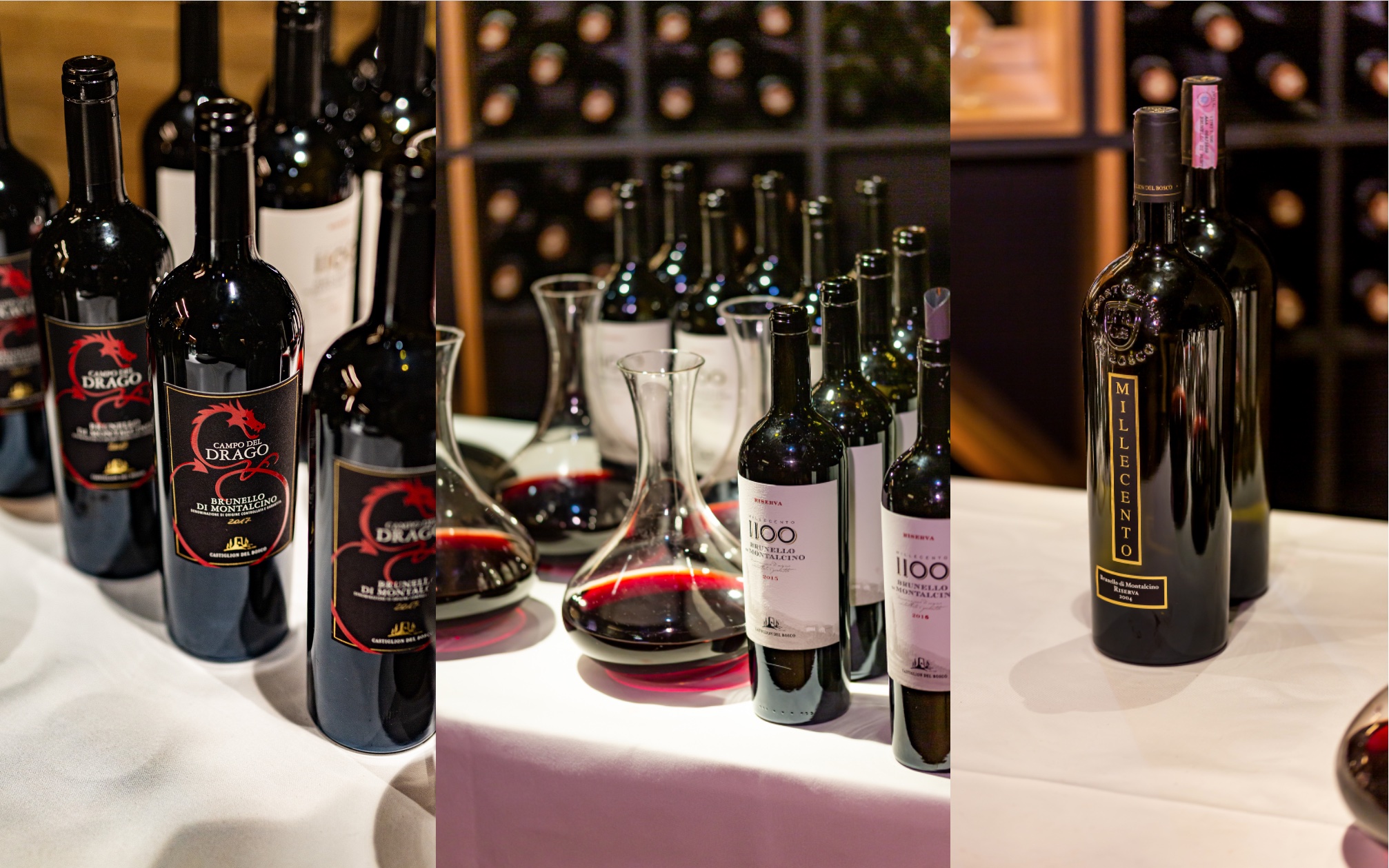 Campo del Drago 2017 (left), Riserva Millecento 2015 and 2016 (middle), and Riserva Millecento 2004 (right)
Campo del Drago 2017 (left), Riserva Millecento 2015 and 2016 (middle), and Riserva Millecento 2004 (right)
Bringing to life the best of Brunello
The Castiglion del Bosco team came to London on Thursday 14th November to tell the tales of the Riserva Millecento 2016 to an audience of 25 industry members and fine wine collectors. Bringing Tuscany to Chelsea, and the estate’s historic past to the present, all guests left with a short storybook, detailing key moments at Castiglion del Bosco that shape the estate’s future, and of course, its wines.
The chosen pouring order of wines, paired with a traditional Tuscan fare from Enoteca Turi’s Head Chef, Massimo Tagliaferri was also symbolic of the changing hands of time, and those traditions maintained – vintages 2004, 2010, 2015, and 2016 we served side-by-side, and tasters were invited to try from 2004 upwards, and back down again.
2004 was the first Riserva made under the current team, while the 2010 was the first to be released under the “Millecento” name. A direct comparison of the 2015 and 2016 – the latest Riserva released, and that which is yet to come – illustrates what Cecilia describes as “two different approaches to quality” in consecutive years.
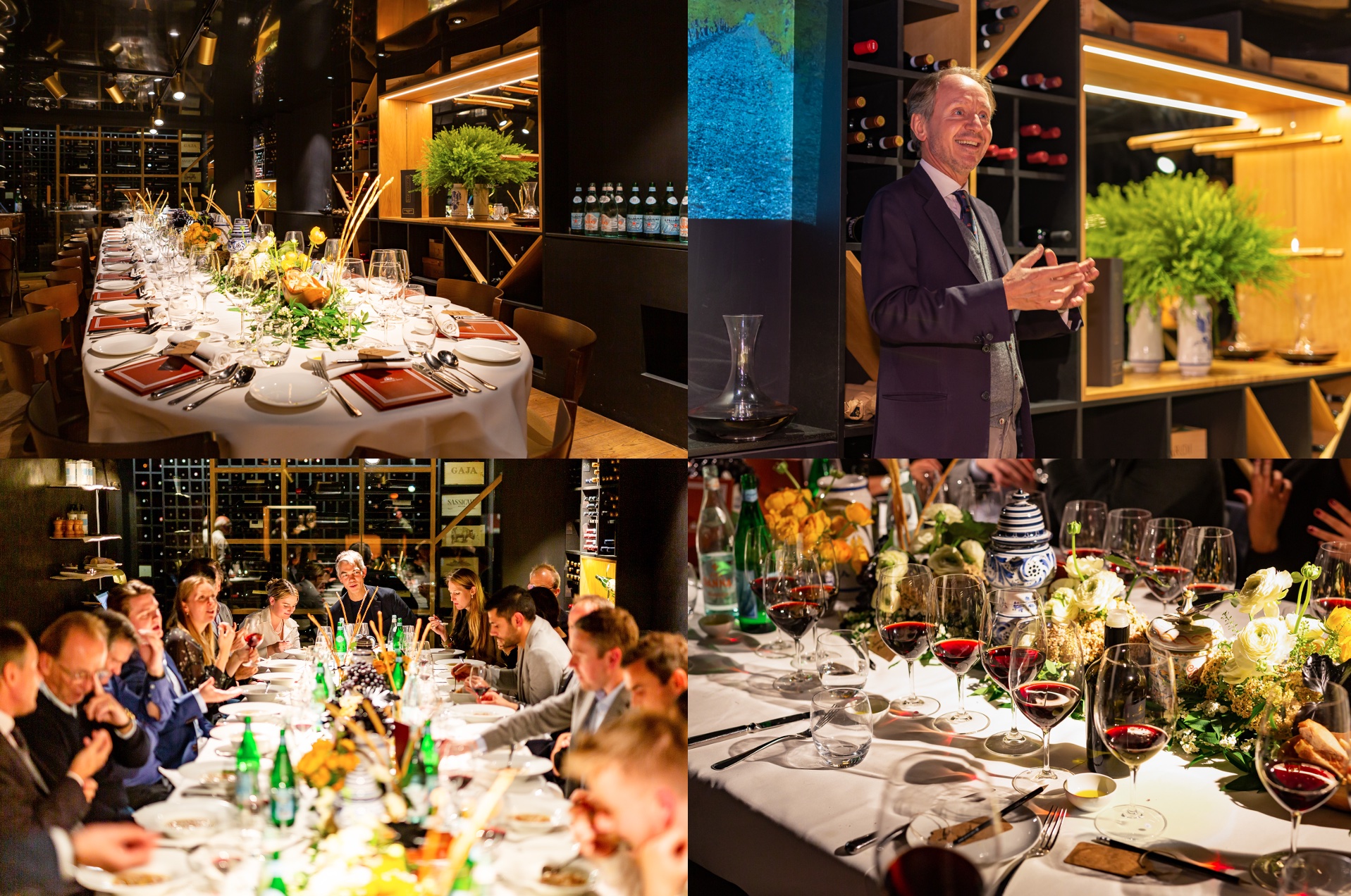 Table designed by Isabelle Buckland (top left), Castiglion del Bosco’s CEO, Simone Pallesi greeting the guests (top right), guests enjoying their aperitivo, Zuppa di Cipolle (bottom left), and the complete Riserva line-up (bottom right)
Table designed by Isabelle Buckland (top left), Castiglion del Bosco’s CEO, Simone Pallesi greeting the guests (top right), guests enjoying their aperitivo, Zuppa di Cipolle (bottom left), and the complete Riserva line-up (bottom right)
Wines tasted: Brunello 2017, Campo del Drago Brunello 2017, Riserva Millecento 2016, Riserva Millecento 2015, Riserva Millecento 2010, and Riserva Millecento 2004 (from Massimo Ferragamo’s private cellar), and a Vin Santo 2014 to finish.
For more information on our organisation of tastings and events, please contact the WLPR team here.
The balancing act
Following our recent report on Bordeaux’s 2021 harvest, Wine Lister now turns to Tuscany to find out more about its 2021 vintage so far, with insight from 10 top producers across the region
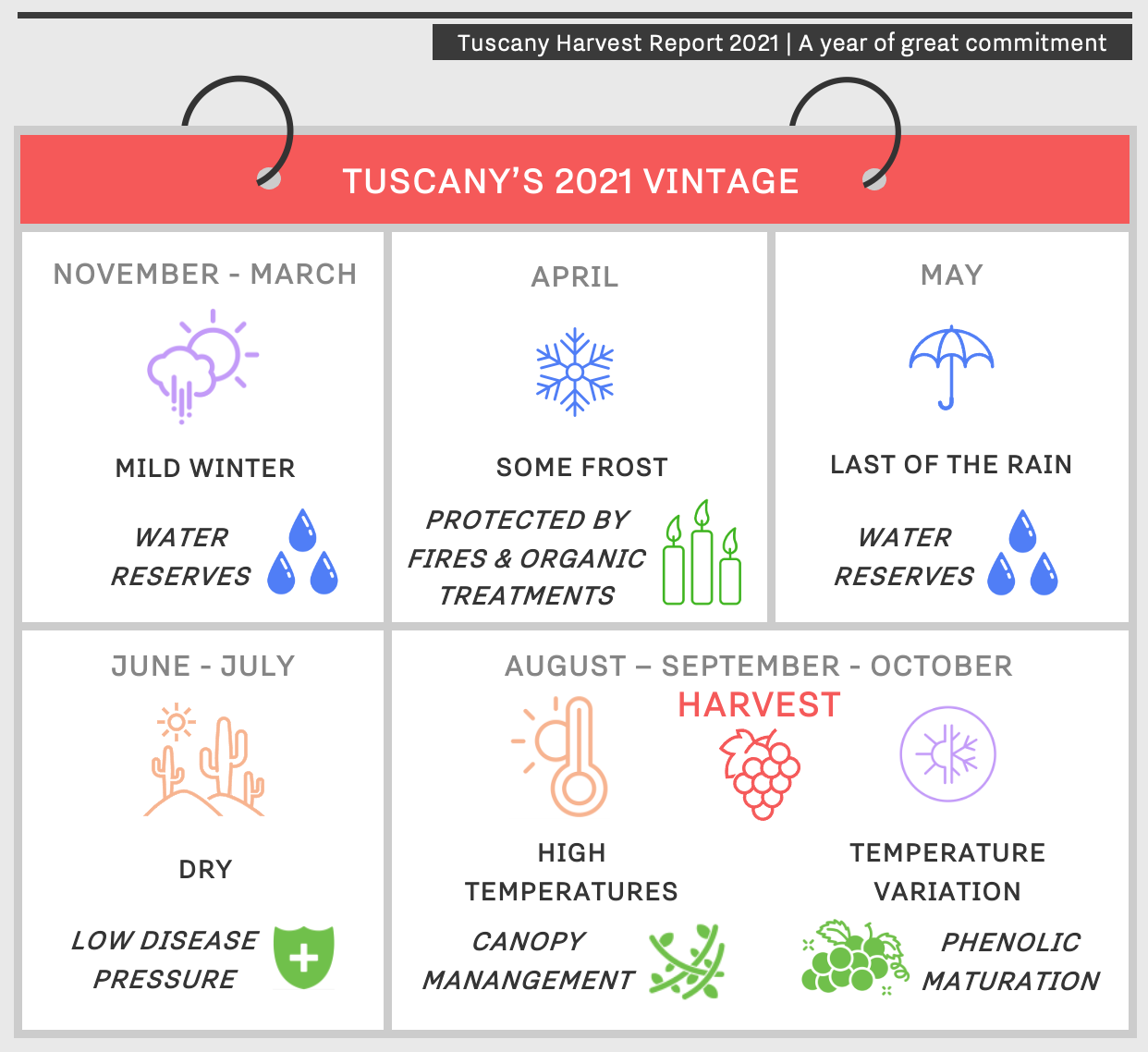
Tuscany’s 2021 growing season has been characterised as a year of climatic extremities, including a mild and rainy winter, the onset of frost in spring, persistent drought in summer, and ending in ideal harvest conditions. In a show of resilience and adaptability, producers were able to reap the benefits of acute weather patterns – with the potential consequences of drought lessened by the groundwater reserves accumulated in winter, and dry conditions reducing disease pressure over the summer.
What can we expect from Tuscany’s 2021 vintage?
Multiple methods to fight frost
- Properties lit fires in the vineyards to circulate warm air and reduce the risk of frost. Owner of IPSUS, Giovanni Mazzei tells us that the technique successfully “increased the temperature up to 2˚C” across the IPSUS vineyards, protecting the vines from damage
- Several producers used organic treatments to improve vine health following the frost, including Argiano, whose Sales Manager, Riccardo Bogi tells us that “brown algae allowed the plants to stabilise and respond as quickly as possible to the loss of sprouts”
- Frost was particularly prevalent in low-lying coastal regions, with Ornellaia’s winemaker, Axel Heinz witnessing “damages limited to a few lower altitude vineyards, without significant impact on production”. Le Macchiole’s Commercial Director, Gianluca Putzolu tells us that the estate also implemented “organic spring fertilization” to combat frost that hit “some, but fortunately very few vineyards”
Water reserves
- Rainfall during winter accumulated important water reserves at both Argiano and Romitorio, encouraging a good state of hydration ahead of the growing season
- Some high-altitude properties also saw snowfall during winter that, when melted, “percolated the soil with water”, according to Romitorio’s owner, Filippo Chia
- Abundant rainfall in May allowed plants to survive the hot summer, with Riccardo confirming that this was “essential” for Argiano’s 2021 vintage, “since after that, there was no rain until the beginning of October”. Similarly, Fèlsina’s owner, Giovanni Poggiali tells us of some “rainy days in June”
Sun and heat exposure
- “The management of the canopy needed to be delicate and precise to avoid sunburns”, explains Avignonesi’s COO and Agronomist, Alessio Gorini, who also explained that the use of high-tech sorting equipment allowed them “to completely remove any berries withered or raisined by the sun”
- Organic treatments were adopted to protect the vines from sun exposure, such as the use of “kaolin” at Tenuta San Guido. General Director, Carlo Paoli explains this to be “a natural substance that we have been using for many years in hot vintages”, which helps to reduce the vines’ susceptibility to scorching
- A broad diurnal range across several high-altitude estates encouraged balance despite the hot summer, with Castiglion del Bosco’s winemaker, Cecilia Leoneschi noting that the difference of more than 10°C between day and night temperatures was a “real blessing”
 Teamwork amongst Tuscan vines: IPSUS (left), Tenuta San Guido (middle), Ornellaia (right)
Teamwork amongst Tuscan vines: IPSUS (left), Tenuta San Guido (middle), Ornellaia (right)
A remarkably healthy vintage
- Lack of rain throughout June and July minimised disease pressure; Filippo confirmed that “from a mould and disease standpoint, it was actually one of the healthiest vintages [Romitorio] has seen”, thanks to the “dry summer”. Giovanni echoes this sentiment for IPSUS, while Gianluca reiterates there were “no particular problems” at Le Macchiole, despite the risk of powdery mildew – a more common problem for the Bolgheri area
Striking when the time was right
- For many estates, harvest timing was essential, with Alessio and the Avignonesi team similarly conscious of “avoiding over-ripening on such concentrated grapes”
- Producers had to be particularly reactive to picking dates, explains Axel – whose 2021 harvest “required great skill” in planning, eventually leading to a “very compact harvest completed in one month, instead of the usual 40 days”. Owner of Tua Rita, Giovanni Frascolla similarly characterised 2021 as a “lightning harvest”
Balanced acidity
- “Powerful dark structure – we normally see this with low acid, but this has high acid” recounts Filippo from Romitorio’s latest tasting of the blend
- First impressions show “bright aromatics and, luckily high acidities to keep everything in balance”, at Ornellaia, with Axel describing a “rich and concentrated” wine, “with soft tannins”
- “Grapes matured in a homogeneous way and with a perfect balance of acidity and PH” explains Carlo at Tenuta San Guido
Margaux’s Wine of the Vintage?
Our latest article takes a closer look at one of the final entries in the Place de Bordeaux’s September 2021 Campaign, as we examine Palmer’s re-release from one of Bordeaux’s most challenging recent vintages.
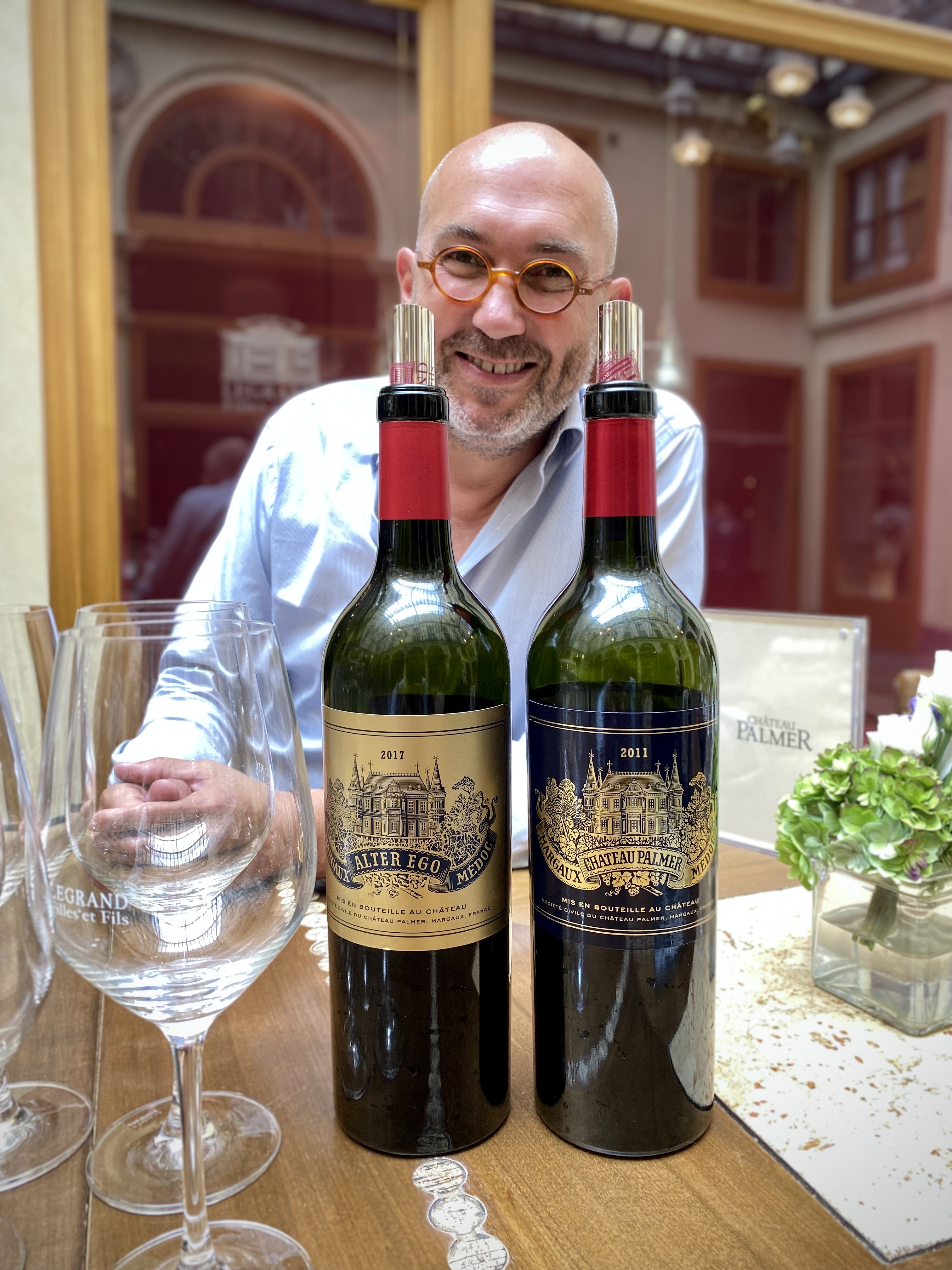 Palmer’s Director, Thomas Duroux tasting Palmer 2011 and Alter Ego 2017 with Wine Lister CEO, Ella Lister
Palmer’s Director, Thomas Duroux tasting Palmer 2011 and Alter Ego 2017 with Wine Lister CEO, Ella Lister
What is the story behind Palmer’s 2011 vintage?
Palmer’s precious secrets
A decade on from production, Thursday 23rd September saw the re-release of Palmer 2011 with a recommended UK onward selling price of £228 per bottle (in-bond). This release represents the second instalment of their ‘10 years on’ series, which presents decade-old ex-château stocks to the market via the Place de Bordeaux. While still releasing Palmer’s latest vintages en primeur, the estate’s Director, Thomas Duroux tells Wine Lister CEO, Ella Lister that withholding stock for ex-château release for 10 years plays tribute to Émile Peynaud’s philosophy that “A great wine needed at latest 10 years of age before it was ready to drink”.
The story of a peculiar vintage
Building momentum amongst merchants and collectors for the release of a notoriously challenging vintage is no mean feat. Duroux’s deft storytelling played on the strengths of Palmer’s historically low yields, reminiscing the events of this curious vintage to encourage interest in the re-release. With a mere 20 hl, the 2011 produced less than half the yield of a normal year, and the even-greater scarcity of re-release availability (approximately 1,000 cases) was surely designed to entice further demand. Several Bordeaux properties suffered at the hands of a significant hailstorm on 4th June 2011, with some falling victim to damage in the crucial berry set period. Although Palmer felt the effects of the growing season, it nonetheless still produced a well-scored wine, matching the average WL score of first growths Margaux, Lafite, and Mouton (93).
Crunch time
Duroux links the quality of their 2011 to the somewhat merciful timing of the hailstorm. Having passed through flowering, the berries were small and able to withstand the storm’s impact, with the damage sustained mostly by the vine’s young shoots. Since the vines compensated by rerouting their energy to grow new shoots, they devoted less energy to fruit development, therefore the harvest yielded a smaller collection of concentrated berries. Such details serve as a good reminder, that the story of a vintage can only paint a partial (and general) picture – digging into the detail of each estate can uncover so much more potential.
Key fine wine releases from Bordeaux and Beyond
As another week of releases draws to a close, we reflect on highlights from the past fortnight, including the latest vintages of signature New and Old World wines, offered through the Place de Bordeaux’s impressive network.
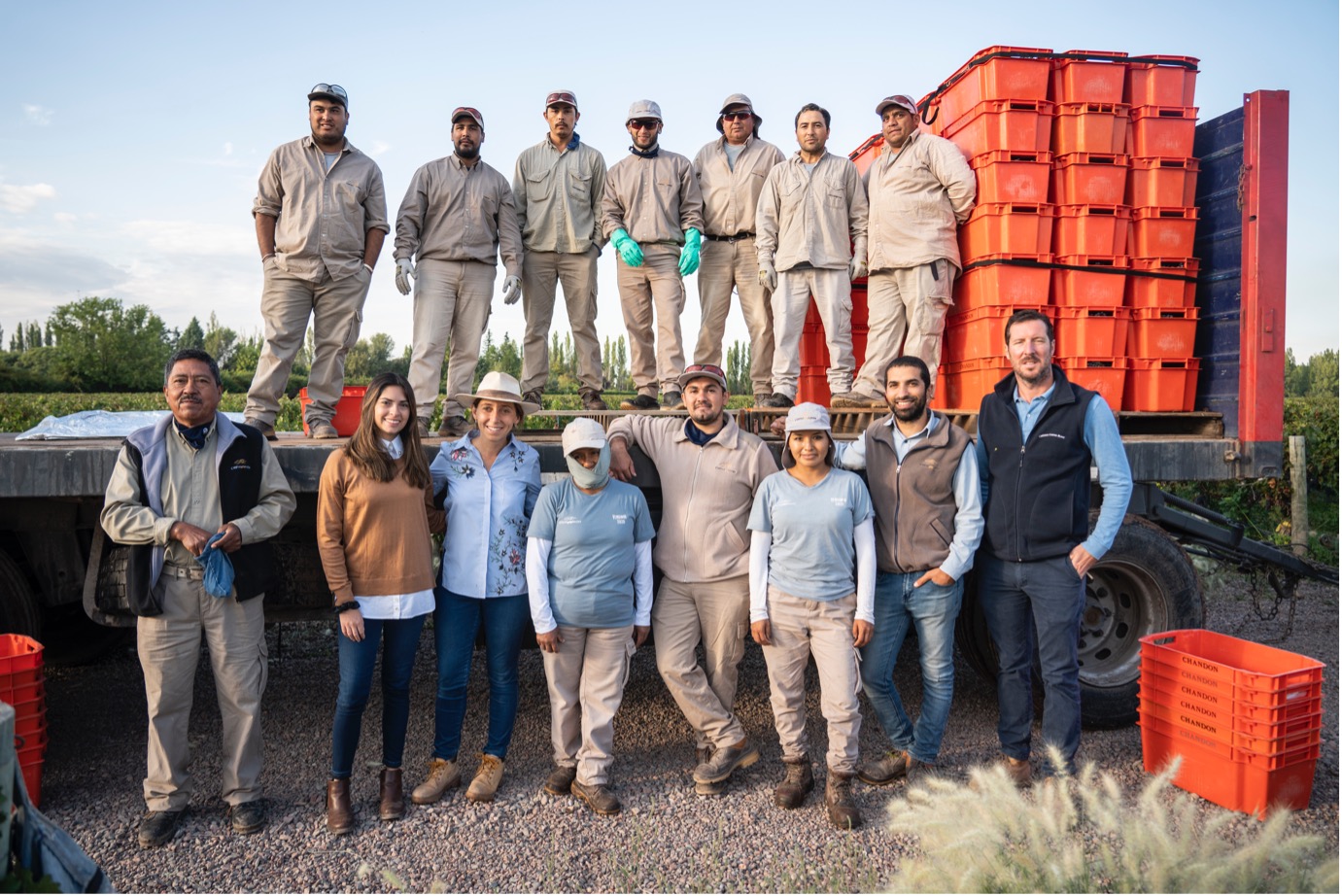 Cheval des Andes’ Technical Director, Gerald Gabillet (bottom right), with the winemaking team
Cheval des Andes’ Technical Director, Gerald Gabillet (bottom right), with the winemaking team
Which wines offer the best investments from the Place de Bordeaux’s September campaign?
As well as a further flurry of releases from the Americas and Tuscany, the past two weeks have also witnessed exciting French entries from the likes of the Rhône Valley, and a re-release of Latour 2005.
California dreaming
One of the top 20 fine wine brands in the world (according to its Wine Lister Pro Brand score), Opus One released its 40th vintage, 2018 last Monday (6th September), at £230 per bottle (in-bond). Wine Lister partner critic, Antonio Galloni (Vinous) gives the latest release a score of 95, describing it as “incredibly elegant and polished, right out of the bottle”.
Napa Valley neighbour, Beaulieu Vineyard’s Georges de Latour Private Reserve 2018 was released on Tuesday (14th September) at £115 per bottle (in-bond). Describing the wine as “sensational”, with notes of “inky red fruit, chocolate, leather, and liquorice”, Galloni gives the latest vintage 98 points – its joint-highest score ever awarded by the critic body. Joseph Phelps’ Insignia 2018 entered the market in quick succession on Tuesday at £163 per bottle (in-bond). Sampled by Wine Lister COO, Chloe Ashton at a recent tasting at 67 Pall Mall (alongside the 2010 and 1998), she found the evolution in complexity, tension, and precision was clear to see.
Monday (13th September) witnessed a triptych of 2018s from Sonoma County’s Vérité, with La Muse, Le Désir, and La Joie released onto the market at £300 per bottle each (in-bond). With the wines representing distinct expressions of the estate through the bespoke blending of different varietals and plots, the Merlot-based La Muse receives a perfect 100-point score from Lisa Perrotti-Brown for Wine Advocate, who calls it “Electrifying!”. Comprising a majority blend of Cabernet Franc, Le Désir gains 97+ and 97 points from Perrotti-Brown and Suckling, respectively. Whilst being Wine Lister CEO, Ella Lister’s favourite amongst the three, the Cabernet Sauvignon-dominant La Joie 2018 secures its highest average critics scores since 2013, inclusive of 98 points from Perrotti-Brown and 99 points from Suckling.
South American sensations
Leading last week’s South American entries, Baron Philippe de Rothschild’s Chilean winery Almaviva released its 2019 vintage on Wednesday (8th September) at £108 per bottle (in-bond). The Wine Lister team found it to show good complexity for its young age, with dense black fruit, exotic spices, and a touch of hay smoke.
Across to Argentina, Cheval des Andes 2018 was released on Thursday (9th September) at £59 per bottle (in-bond). The latest vintage aligns with the estate’s upward quality trajectory in recent years, having been awarded a score of 98 from James Suckling, who describes it as “very long and structured, yet controlled and in balance”.
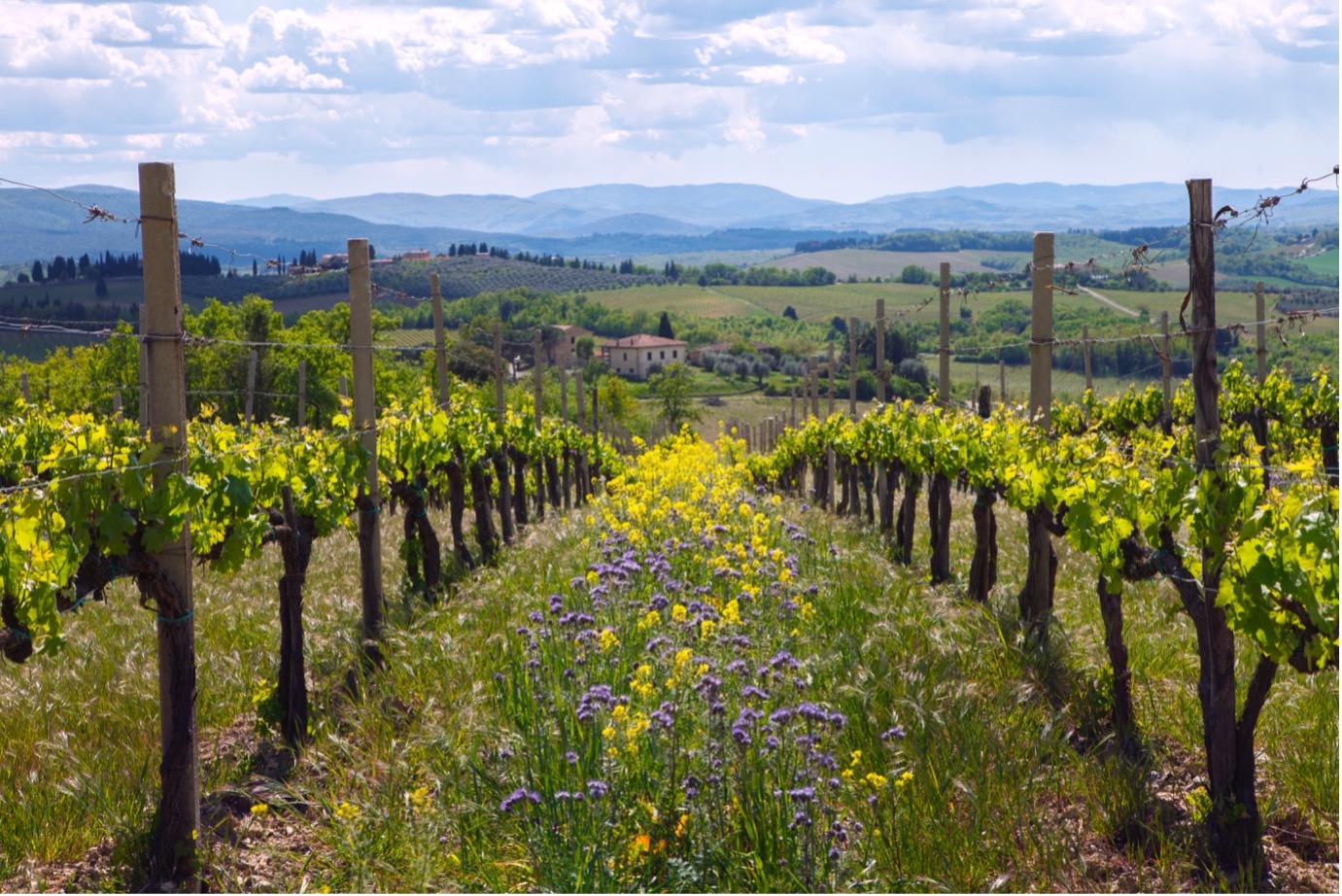 Wildflowers growing in-between Siepi’s Merlot and Sangiovese vines
Wildflowers growing in-between Siepi’s Merlot and Sangiovese vines
A Tuscan triumph
There are now only limited remaining stocks of Masseto 2018, which was released on Tuesday (7th September), starting from £495 per bottle (in-bond). The estate saw one of the rainiest springs in its history, and consequentially faced high levels of disease pressure. Nonetheless, the team at Masseto handled challenges that arose deftly, reflected in Wine Lister’s praise of its dense, layered, and lithe texture.
Now with similarly limited availability at around £208 per bottle (in-bond), Solaia 2018 was released on Thursday (9th September). Galloni awards it a strong score of 98, noting that he “can’t remember ever tasting a young Solaia with this much sheer appeal and balance”. Demand for the 2018 may well be encouraged by the estate’s positive price performance track record, which has seen some of its top-scoring vintages appreciate significantly post-release.
The first of the Tuscan trio to be released last week was Petrolo’s Galatrona 2019, which entered the market on Monday (13th September) at £72 per bottle (in-bond). Gaining a near-perfect score of 99 points from Suckling, he describes it as “muscular, yet agile” – “a unique definition of merlot in Tuscany”. Following in close succession, Castello di Fonterutoli released Siepi 2019 at £68 per bottle (in-bond). The Mazzei family planted its first Merlot grapes in 1980, with Siepi’s varietal blend now comprising equal proportions of Merlot and Sangiovese. The 2019 gains 98 points from Suckling – the joint-highest score awarded by the critic, who praises its “super-structure”, and “finesse with power”. To end Monday’s Tuscan trilogy, Tenuta Sette Ponti’s Orma 2019 was released at £56 per bottle (in-bond). Though Orma is yet to be widely scored by critics, Suckling awards it 97 points, calling it “perhaps the best Orma ever”.
Closing this week’s Italian offerings, Caiarossa 2018 entered the market on Wednesday (15th September) at £35 per bottle (in-bond). Walter Speller for Wine Lister partner critic, JancisRobinson.com, awards it 17+ points, considering it “classy stuff”, “which should become even more compelling with further bottle ageing”.
Back on French soil
Speculated to be the final commercial release of the vintage, Latour released a parcel of its 2005 vintage last Tuesday (7th September), which has since been offered by merchants for around £750 per bottle (in-bond). The 2005 was awarded 100 points by Galloni, who calls it “deep and sensual to the core”, and notes that it is “utterly captivating”. The iconic reputation of both the vintage and the estate is reiterated in this perfect score, which should stimulate interest from serious fine wine collectors.
Racing over to the Rhône, Beaucastel Hommage à Jacques Perrin 2019 was released last Friday (10th September) at around £227 per bottle (in-bond). A cask sample score from Alistair Cooper for JancisRobinson.com signifies quality, awarding its highest score from the critic body since 2007 with 19 points, calling it “One to watch!”.
Click here to sign up to Wine Lister’s newsletter to stay up-to-date with the latest from the Place de Bordeaux’s September campaign.
The best bottle for your budget
Considering the best of white Burgundy MUST BUYs across five different price points, these potential picks gain high WL scores and are all approaching or within their drinking window parameters. Wine Lister’s MUST BUY algorithm produces initial recommendations through considering a wine’s quality and value within its vintage and appellation.
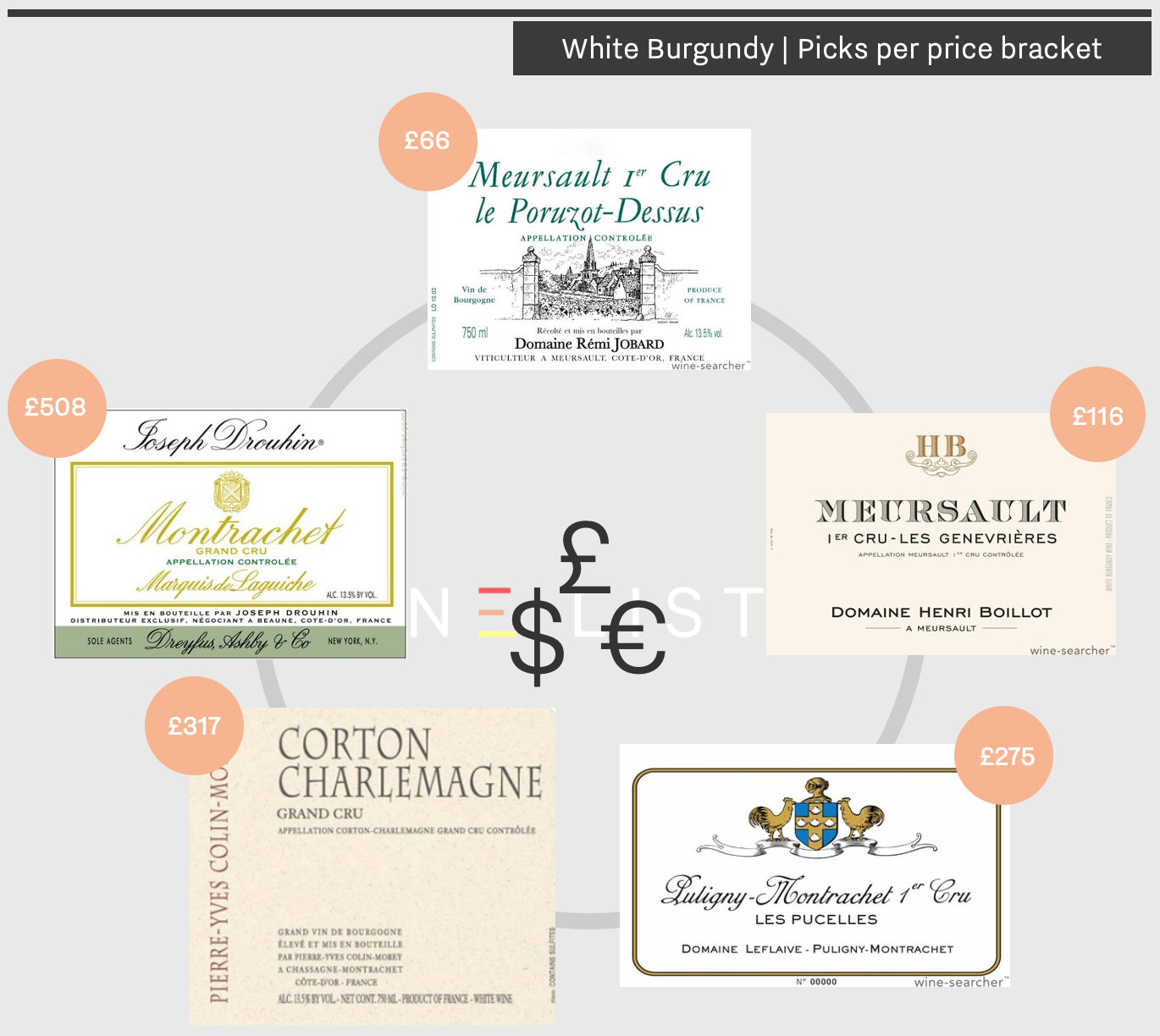 White burgundy MUST BUY picks per price bracket (per bottle, in-bond)
White burgundy MUST BUY picks per price bracket (per bottle, in-bond)
Which are the best white Burgundy wines for my budget?
Notorious for housing wines of high quality with equally high demand, Burgundy has seen some extreme price rises over the last few years. Below we explore top white Burgundies with availability across a range of prices.
With a history of winemaking in his family dating back to the 15th century, Rémi Jobard took over his namesake estate from his father in 1996, and has since overseen many developments. As well as converting to an organic practice in 2008 (and gaining certification in 2011), Rémi introduced cover crop growth across his seven vineyards to encourage the 60+ year old vines to grow deeper to find nutrients. Harbouring a naturally limited yield through cordon-pruning, Rémi Jobard produced just 2,700 bottles of Meursault Le Ponuzot-Dessus in 2015. Despite this, there is still some available of the vintage for under £100, which can be purchased from Lea & Sandeman at around £66 a bottle.
Since taking over the helm of his family property in 2005, fifth-generation wine maker, Henri Boillot has implemented several changes at Domaine Boillot. As well as a focus on sustainable farming methods, including the avoidance of chemicals, and manual harvesting, the team conducts heavy pruning to limit yields, and harvests fruit as late as possible to ensure maximum phenolic maturity. White grapes are crushed gently to avoid bitterness, and fermented in larger barrels than the typical Burgundy “pièce” (350l, vs. 228) to ensure that purity and freshness is unencumbered. Achieving a WL score of 94, the 2016 vintage can be enjoyed at its best for another 10 years, and is available to buy from Fine+Rare at £116 a bottle.
The Leflaive family legacy has been propelled into a modern era, under the founder’s great-grandson and fourth generation leader, Brice de La Morandière since 2015. As part of increased investment into refining its practice, Leflaive introduced a new type of cork in 2016, from natural cork to DIAM (made from broken down natural cork, cleaned with carbon dioxide), which increases the longevity of its bottles. MUST BUY Puligny-Montrachet Les Pucelles 2014 achieves a WL score of 94, and can be found at Corney & Barrow from £275 a bottle.
The son of Burgundy’s infamous Marc Colin (whose domain expands across 30 different appellations in the region), Pierre-Yves established his own project in 2005 from vineyards he inherited from his father. He deviates from traditional Burgundian vinification methods, utilising larger demi-muid barrels (600l) to moderate the influence of oak on the wine and preserve the purity of fruit. Gaining Buzz Brand and Investment Staple status, Pierre-Yves Colin-Morey Corton-Charlemagne 2018 has WL score of 95, and provides a solid bet for top-quality white Burgundy to lay down for the future. It can be sourced from Berry Bros. & Rudd at £317 a bottle.
Produced by négociant house Joseph Drouhin with grapes sourced from vineyards owned by the Laguiche family of the Montrachet Marquis de Laguiche estate, Joseph Drouhin’s Montrachet Marquis de Laguiche 2013 is a MUST BUY at the premium end of white Burgundy offerings. Founded in 1880 by 22-year-old Joseph Drouhin himself, the legacy of its founder’s production has been carried through generations, with the property now under the helm of his four grandchildren, Fréderique, Véronique, Philippe, and Laurent. Receiving a WL score of 96 at around £508 a bottle, the 2013 has 10 more years left of enjoyment. To get your hands on this vintage, you can place a bid for it on the Berry Bros & Rudd online marketplace, BBX.
N.B. All prices are quoted per bottle, in-bond and are correct at the time of publication (19th August 2021).
To keep up to date with our fine wine insights, be sure to subscribe to our free newsletter: https://www.wine-lister.com/subscribe/info
Keeping it in the family with the best value second wine picks
Further informing your Bordeaux 2020 purchases, we look at the top 20 second wines of the vintage by Wine Lister’s value score. The score is calculated based on the quality to price ratio of a wine and vintage, while still allowing room for higher-priced wines to feature.
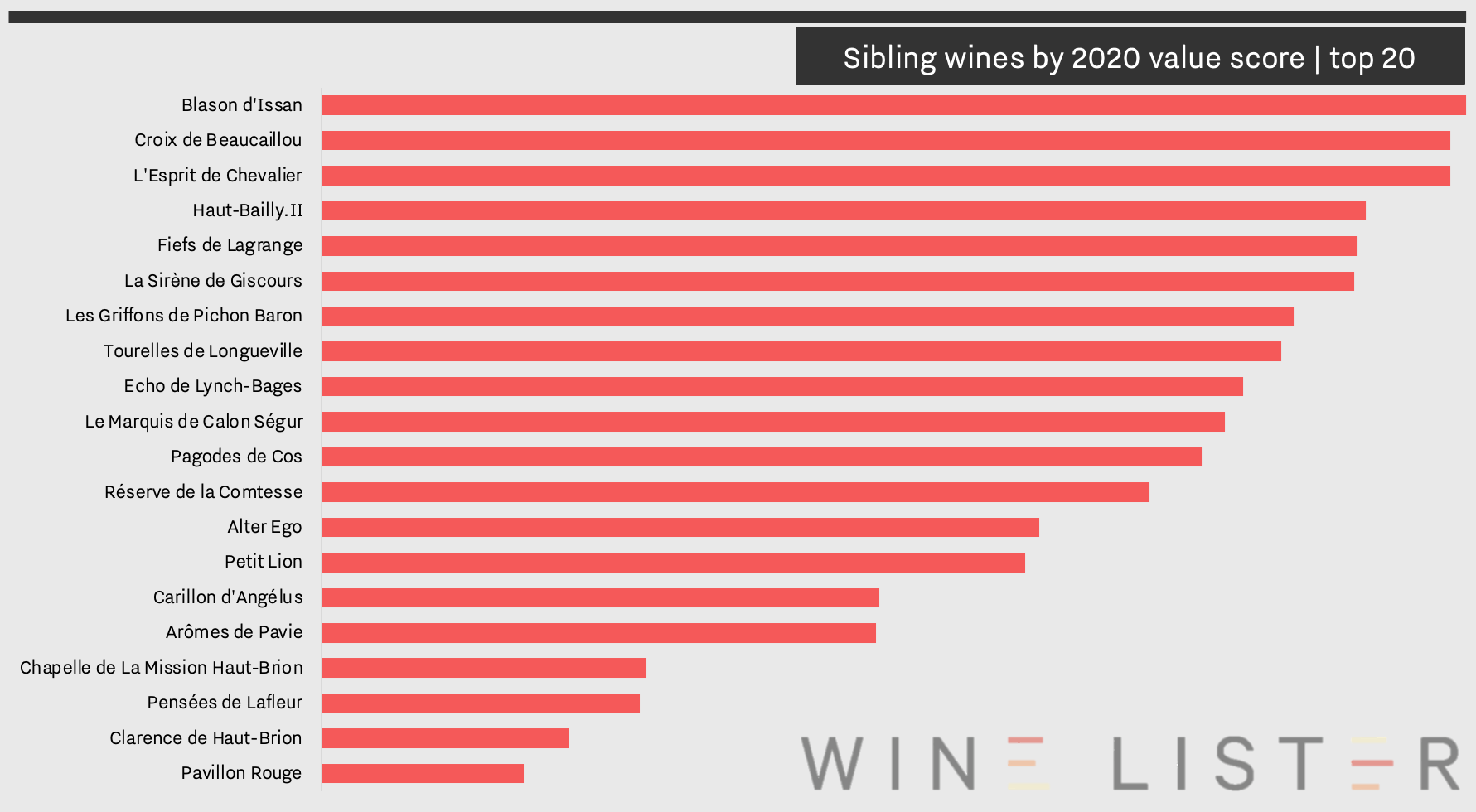 The top 20 leading sibling wines by Wine Lister value score
The top 20 leading sibling wines by Wine Lister value score
Which second wines provide the greatest value?
Often lurking in the shadows of their Grand Vin counterpart, sibling wines offer a high quality, more accessible alternative to Bordeaux’s long-ageing elite. While some are the product of grapes remaining from the Grand Vin, other producers prefer to give a sibling wine its own dedicated plots, often of slightly younger vines. In either case, these wines made at the hands of some of the world’s greatest winemakers should be considered seriously. Below we look at our top picks of sibling wines for value, based on the latest offerings from the Bordeaux 2020 en primeur campaign.
Left Bank legacies
All major Bordeaux appellations across both banks are well-represented amongst the top 20 value picks, with Margaux property, d’Issan achieving the greatest value score for the 2020 vintage. First produced in 1985, Blason d’Issan bears a greater proportion of Merlot than its Grand Vin sibling (57% compared to 39%), but as noted by its maker, Emmanuel Cruse, is still very much a “baby d’Issan”, sporting the château’s perennial style. The second wine of 2020’s wine of the vintage (according to Wine Lister partner critics), Margaux, has been a permanent feature of the estate since the 17th century; christened Pavillon Rogue in 1908, it is 2020’s only top 20 second wine from a First Growth property. Margaux comrade, Giscours, is also represented, by its Sirène de Giscours, which enjoys the same winemaking attention and ageing as the Grand Vin, but with grapes sourced from younger vines. Finally, Margaux majesty, Palmer is featured with Alter Ego. Its 2020 release was well sought-after, particularly after no second wine was produced in 2018.
Pessac-Léognan royalty, Haut-Brion’s Clarence de Haut-Brion ranks among the top 20 sibling wines for value. It is joined by L’Espirit de Chevalier – the red counterpart of Domaine de Chevalier’s sibling series – and Haut-Bailly’s Haut-Bailly II. The latter was renamed (from La Parde de Haut-Bailly) in 2019 to symbolise the second generation of owners, the Wilmers family. Finally, Chapelle de La Mission Haut Brion comes from the same vineyard as the Grand Vin, grown and harvested in the same way, with the introduction of grapes from the older parcels of La Tour Haut-Brion since the 2006 vintage.
Saint-Julien has three properties represented by their second wines, including Croix de Beaucaillou, which ranks in second place. This sibling wine is produced using grapes hailing from its own distinct vineyard, lying to the west of the château. Completing the top five rankings is Fiefs de Lagrange, which bears familiarity to its Grand Vin sibling, but is more suited for earlier drinking. Finally, Léoville Las Cases’ le Petit Lion celebrates its 13th vintage with the release of the 2020, produced from a blend of replanted vines that are now between 15 and 18 years of age.
In neighbouring Saint-Estèphe, Le Marquis de Calon Ségur and Pagodes de Cos occupy 10th and 11th place respectively, with the former taking very different form from their first wine as an alternative interpretation of the Calon terroir. The latter is produced from a separate, dedicated plot of 40-year-old vines.
Completing the Left Bank selection are four Pauillac value picks, of which two hail from the same property. Pichon Baron is the only property to see its two additional wines feature – Les Griffons de Pichon Baron and Tourelles de Longueville. Lynch-Bages’ Echo joins them within the top 10 picks by value score. Finally, Pichon Comtesse’s Réserve de la Comtesse – first sold in 1973 – is a top feature for en primeur 2020. This well-established sibling wine represents between 20% to 50% of Pichon Comtesse’s total production.
Right Bank relatives
One the Right Bank, and particularly in Pomerol, sibling wines have been slower to catch on, simply due to lower production levels per property. Two Saint Emilion Classés A properties nonetheless stand out for sibling value picks– Pavie and Angélus – featuring Arômes de Pavie and Carillon d’Angélus, respectively. The latter is increasingly becoming a “cousin” rather than a sibling, since the property has recently invested heavily in new plots for Carillon alone. Amongst this top pick hoard is Pomerol estate, Pensées de Lafleur, which takes 13th place amongst the top value picks with a limited-production of 500 cases.
As well as gaining top scores across its reds, Bordeaux 2020 was successful for dry whites, notably at the highest level. Helping you to discover some of the leading examples, we explore the top five Bordeaux 2020 dry white wines by WL score.
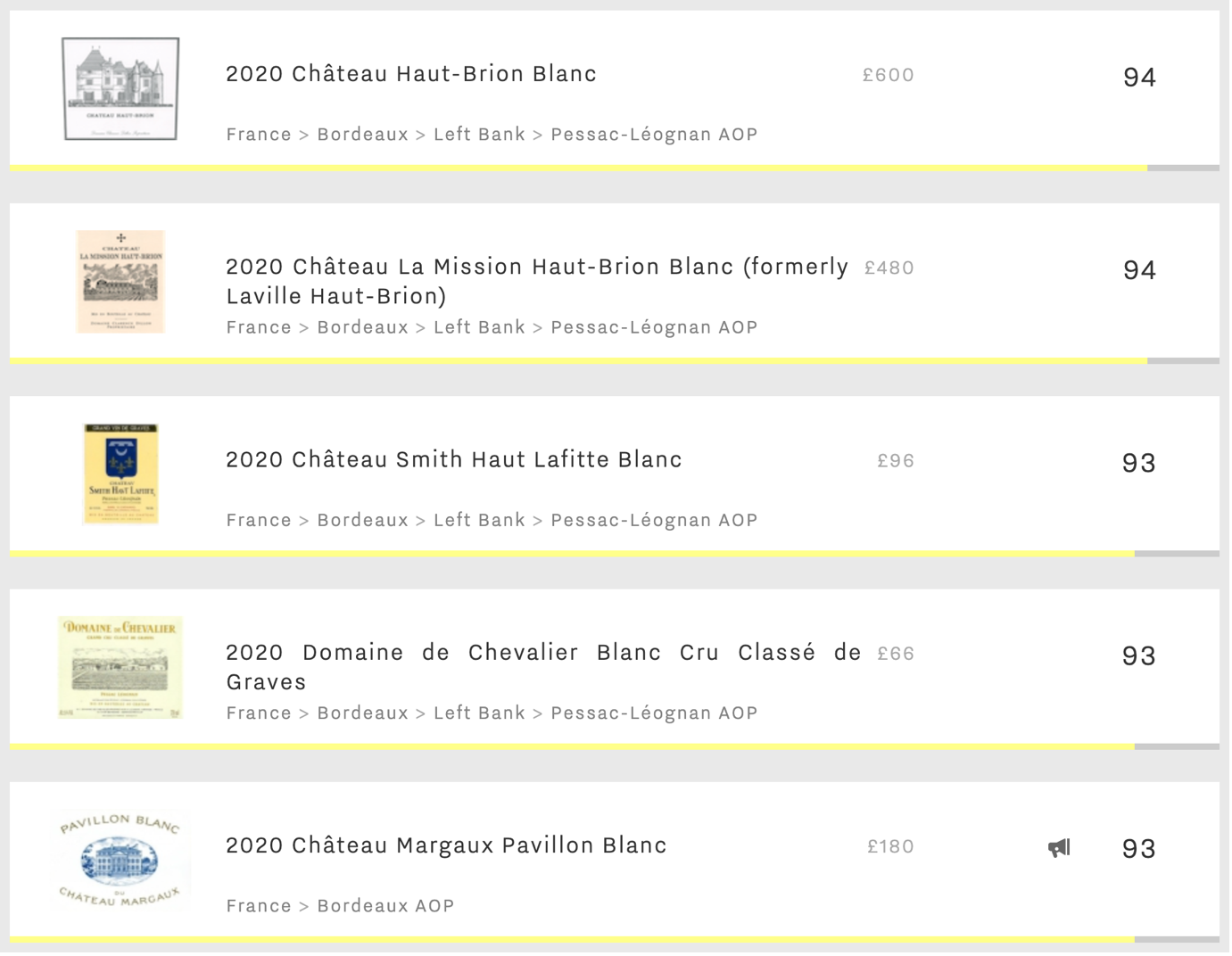 The top dry Bordeaux whites of the 2020 vintage, displayed in order of WL score
The top dry Bordeaux whites of the 2020 vintage, displayed in order of WL score
Will 2020 be a good vintage in Bordeaux for dry white wines?
Despite another exceedingly warm growing season in 2020, Bordeaux’s earlier-ripening white grapes fared well across many of the region’s top blanc producers. Having seen one of the earliest harvests on record, the first Sauvignon Blanc grapes were picked on the 14th of August, and all fruit destined for dry whites was harvested by early September. The white Bordeaux vintage therefore avoided high temperatures during the rest of the month, maintaining balance and freshness.
With a remarkably small production of just c.600 cases per annum, Haut-Brion Blanc remains one of the most sought-after Bordeaux dry whites. To combat the warm summer temperatures, the team conducted pre-dawn harvesting, picking grapes during the cooler night-time climate to ensure better levels of acidity and freshness. Wine Lister CEO, Ella Lister, found Haut-Brion Blanc to show “an almost Burgundian minerality accompanying its unmistakable Pessac green and yellow-fruit character”. With a WL score of 94, it champions the leader board of Bordeaux dry whites for the last four vintages, and there is still some of the 2020 available to purchase en primeur at IG Wines for £600 per bottle (in-bond).
Haut-Brion’s sibling estate, La Mission Haut-Brion’s white is characterised by a Sémillon-dominated blend – a grape with naturally low acidity compared to Bordeaux’s other white varietals. With soaring summer temperatures in 2020, the team therefore increased the percentage of Sauvignon Blanc in its blend to 54.7% (up from 30.1% in 2019) to ensure balance. Ella notes the impact of the increased Sauvignon on the wine’s acidity, describing a “zippy acidity, zingy energy, [with a] peach stone finish.” La Mission Haut-Brion’s white gains a WL score of 94 for the 2020 vintage, and can be found at Justerini & Brooks for £480 per bottle (in-bond).
Smith Haut Lafitte Blanc’s white vines are planted just behind the château to the north, where they benefit from a cooler microclimate that withstood high temperatures in 2020. Technical Director, Fabien Teitgen found a “nice balance and liveliness” in the grapes after harvest, while Ella characterises the 2020 as “subtle and flirtatious, building slowly into notes of white pepper and lime, as well as pure white fruit”. Gaining a WL score of 93, Smith Haut Lafitte blanc 2020 is available at Honest Grapes for £96 per bottle (in-bond).
Located at the heart of the Landes pine forest, Domaine de Chevalier’s vines are also subject to a cooler microclimate as a result of the surrounding woodland, which was certainly welcomed in 2020. When sampling the latest release at the estate, Ella enjoyed the richness of the vintage, noting “Aromas of tangerine, white flowers, custard, and acacia honey” and a palate that is “creamy and caressing […] with a lift of tension and a savoury bite.” Receiving a WL score of 93, Domaine de Chevalier Blanc 2020 can be acquired from Berry Bros & Rudd for £68 per bottle (in-bond).
Though First Growth Margaux has been producing a dry white for over 300 years, Pavillon Blanc 2020 marks the 100th anniversary under its current name. The only non-Pessac pick to feature in the top-five ranking, the success of the latest release was not without its challenges. Tasting alongside Margaux’s Managing Director, Philippe Bascaules, and Business Development Director, Alexis Leven-Mentzelopoulos, Ella was informed of the high mildew pressure as a result of a hot wet spring in 2020, which risked affecting the Sauvignon Blanc grapes of their single-varietal wine. Nevertheless, their 2020 receives a WL score of 93, with Ella describing a “Really rich, mouthcoating texture on entering the mouth – almost a Chardonnay-esque opulence”, and declaring the wine “Delicious.” Pavillon Blanc 2020 can be purchased en primeur from Goedhuis & Co for £180 per bottle (in-bond).
New additions from this year’s offerings
With the Bordeaux 2020 en primeur campaign now concluded, Wine Lister’s latest MUST BUY update includes 13 new picks from the latest vintage, covering a range of different appellations and price points.
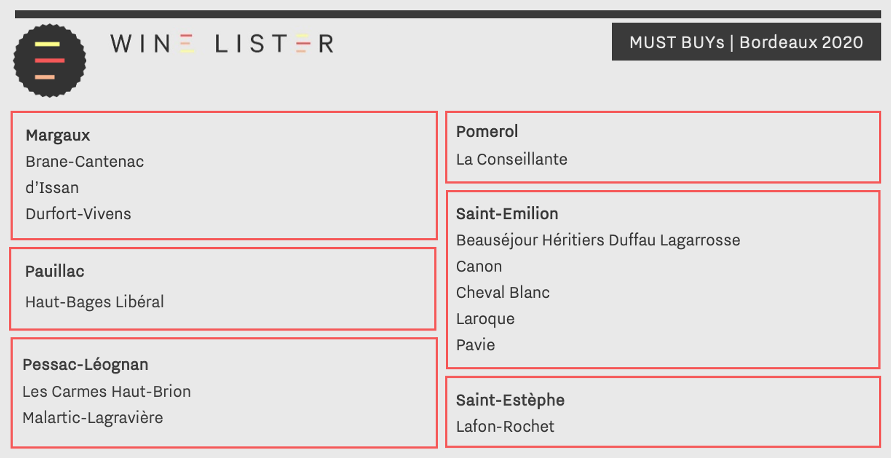 New 13 MUST BUY additions from Bordeaux 2020
New 13 MUST BUY additions from Bordeaux 2020
What are the MUST BUYs from Bordeaux 2020?
Wine Lister’s MUST BUY algorithm takes into account a wine’s quality and value within its vintage and appellation to produce initial recommendations. These results are then filtered through an intelligence-based, human overlay, which identifies MUST BUY wines based on our tasting of Bordeaux 2020, and observation of the reception of each release in the market.
Right Bank insights
Highlighting the success of the Right Bank in 2020, Saint-Emilion houses five of our 13 Bordeaux 2020 MUST BUYs. Amongst the selection is one of Wine Lister partner critic, Antonio Galloni’s (Vinous) “wines of the year”, Pavie 2020, which he scores 97-99, noting “All the elements are well balanced.” The first key release out of the gate this year, Cheval Blanc also gains MUST BUY status. With a score of 96-98 from Neal Martin (Vinous), who calls it “finely proportioned and multi-layered” with a “mineral-driven finish”, the 2020 can be purchased en primeur from Petersham Cellars for £388 per bottle (in-bond).
Beauséjour Héritiers Duffau Lagarrosse, Laroque, and Canon also join the Saint-Emilion entries – the latter gaining praise from Wine Lister CEO, Ella Lister, who describes it as “Full-to-bursting with salivating fruit, just ‘à point’, with impeccable balance”. Canon 2020 can be bought en primeur from £96 per bottle (in-bond) from Honest Grapes.
The Right Bank is represented further by prized Pomerol property, La Conseillante, which retains MUST BUY status for the second vintage in a row. Released at £156 per bottle (in-bond), the 2020 receives a score of 96-98 from Neal Martin, who calls it a “deeply impressive and quite profound La Conseillante”, and is available to purchase en primeur from Goedhuis & Co.
Left Bank investments
Over on the Left Bank, the latest Margaux MUST BUYs comprise 2020s from Brane-Cantenac, d’Issan, and Durfort-Vivens – all of which are available on the market for £50 per bottle (in-bond) or less. d’Issan performs notably well, taking new shape with the introduction of Petit Verdot and Malbec in the latest blend, hailing from new plots purchased by the estate in March 2020. It earns a score of 93-95 from Antonio Galloni, who notes that “Issan is shaping up to be a jewel of a wine.” Appearing in the rankings for most-improved Wine Lister Quality score for a third consecutive year (see our recent blog here), Durfort-Vivens also achieves MUST BUY status in 2020. The estate has seen impressive post-en primeur price performance in recent years, and shows future promise in its upward quality trajectory. Durfort-Vivens’s latest release can be bought en primeur from Justerini & Brooks at £44 per bottle (in-bond).
Pauillac’s Haut-Bages Libéral 2020 receives some of the highest scores ever achieved by the property, including a score of 17 from James Lawther for JancisRobinson.com, who calls it “pure and precise” with “silky and refined” tannins. In neighbouring Saint-Estèphe, Lafon-Rochet also features in the latest MUST BUY haul, with a vintage that marks the inaugural merging of two of the most revered minds in Bordeaux (see our recent blog here). Jean-Claude Berrouet and Eric Boissenot’s joint efforts in 2020 were praised by critics, with Jancis Robinson calling it “a very successful 2020.” Released from £27 per bottle (in-bond), Lafon-Rochet 2020 also gains Value Pick status, and can be purchased at Jeroboams.
Pessac-Léognan provides two MUST BUYs in 2020, with Malartic-Lagravière receiving a score of 93-95 from Antonio Galloni, who describes it as having “An extra kick of energy and vibrancy that is quite attractive”. Les Carmes Haut-Brion 2020 earns 95-97+ from the critic, and can be acquired from Jeroboams for £79 per bottle (in-bond).
Explore all Wine Lister MUST BUYs here, or discover more Bordeaux 2020s here.
Bordeaux en primeur 2020 saw mixed pricing decisions throughout the campaign. To help those still looking to purchase en primeur this year, we examine some of the best offerings from the latest vintage at five different price points. (All prices are quoted in-bond per bottle when purchasing by the case).
Click here to view all Bordeaux 2020 releases, or read more below.
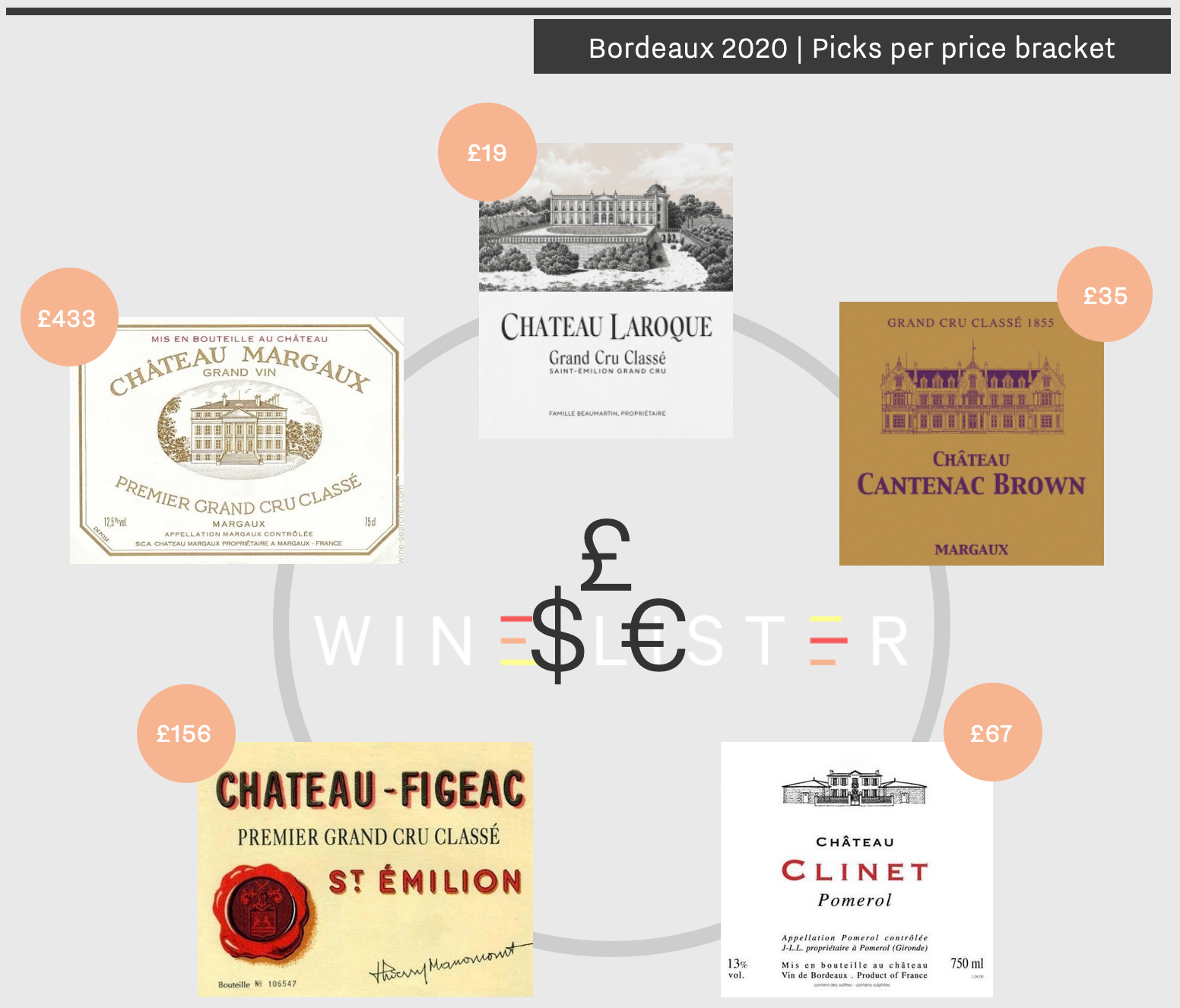
Under £20 – Laroque
Attesting to the estate’s sustained step-up in quality since its 2018 vintage, Laroque receives strong critical praise in 2020. Antonio Galloni and Neal Martin (Vinous) both award 93-95, with the latter calling it, “Possibly the best Laroque that winemaker Suire has overseen to date.” Having worked at fellow Saint-Émilion estates, Bellevue, Beauséjour Héritiers Duffau Lagarrosse, and Larcis Ducasse over the past 15 years, winemaker David Suire joined Laroque in 2015. He has since invested in making significant quality improvements, changing the winemaking process of the Grand Vin to now consist solely of free-run juice and no press wine. The third Laroque release in a row to achieve Value Pick status, the 2020 vintage can be bought from Justerini & Brooks for £18.92 per bottle (in-bond).
Under £50 – Cantenac Brown
The recent acquisition of Margaux Third Growth, Cantenac Brown, by agro-engineer, Tristan Le Lous, brought about a buzz of excitement for his first full vintage at the estate. Under its new ownership, the estate has expanded its vineyards by 9.5ha to incorporate high-quality vines from neighbouring estates, La Galiane and Charmant on the iconic Margaux plateau. Efforts to improve their blend, through the introduction of 70% of the grapes harvested on these new parcels, are reflected in top scores for the 2020 vintage, which receives its highest ever score from Antonio Galloni (94-97). Tasted by Wine Lister CEO, Ella Lister, she calls it, “A very successful Cantenac Brown.” Cantenac Brown 2020 can be purchased en primeur from Goedhuis for £34.33 per bottle (in-bond).
Under £100 – Clinet
Pomerol’s rising star, Clinet once again provides good value within its appellation in 2020. With traces of the vineyard dating back to 1595, one of Pomerol’s oldest estates is managed under the watchful eyes of a small team, co-headed by President of the UGCB, Ronan Laborde. Receiving a score of 94-96 from Neal Martin, he notes, “This is a Pomerol that really wants to make an impression.” Ella found the 2020 vintage to be, “Seamless and languorous. A triumph.” Clinet 2020 is available en primeur at IG Wines for £66.50 per bottle (in-bond).
Under £200 – Figeac
Completing a trilogy of top-scoring vintages, Figeac 2020 highlights the estate’s skilled adaptation to the extreme climate conditions it faced in the year. The team recently reflected on the challenges brought about by “mild winter temperatures, summer heat-waves, and unusually variable rainfall” in 2020, which nonetheless produced one of Ella’s favourite wines from the vintage. Tasting in Bordeaux, she notes a “Trademark Figeac texture. The harmony is mind-blowing.” This Saint-Émilion star can be purchased en primeur from Farr Vinters for £156 per bottle (in-bond).
Over £300 – Margaux
Margaux is one of Wine Lister’s top picks at the premium end of the en primeur spectrum. The highest-scoring wine of the vintage, Margaux is the only 2020 to receive a WL score of 98 (an average combining all Wine Lister’s partner critics on a 100-point scale). According to the Margaux team, the success of the vintage is down to the amalgamation of “homogenous flowering, summer conditions that favoured small berries, and excellent harvesting conditions.” Indeed, the 2020 receives a score of 19 from James Lawther for JancisRobinson.com, who describes it as the “Perfect pitch”, while Ella was “Wowed”, stating “This will age into eternity, and yet the texture is already soft now.” For those looking to find this First Growth, Margaux 2020 can be reserved for £433 per bottle (in-bond) via Petersham Nurseries.

 Bespoke menu (left), Castiglion del Bosco’s Marketing Manager, Gemma Grieco talking guests through the line-up (middle), Enoteca Turi owner, Giovanni Turi pouring the wines (right)
Bespoke menu (left), Castiglion del Bosco’s Marketing Manager, Gemma Grieco talking guests through the line-up (middle), Enoteca Turi owner, Giovanni Turi pouring the wines (right) Campo del Drago 2017 (left), Riserva Millecento 2015 and 2016 (middle), and Riserva Millecento 2004 (right)
Campo del Drago 2017 (left), Riserva Millecento 2015 and 2016 (middle), and Riserva Millecento 2004 (right) Table designed by Isabelle Buckland (top left), Castiglion del Bosco’s CEO, Simone Pallesi greeting the guests (top right), guests enjoying their aperitivo, Zuppa di Cipolle (bottom left), and the complete Riserva line-up (bottom right)
Table designed by Isabelle Buckland (top left), Castiglion del Bosco’s CEO, Simone Pallesi greeting the guests (top right), guests enjoying their aperitivo, Zuppa di Cipolle (bottom left), and the complete Riserva line-up (bottom right)
 Teamwork amongst Tuscan vines: IPSUS (left), Tenuta San Guido (middle), Ornellaia (right)
Teamwork amongst Tuscan vines: IPSUS (left), Tenuta San Guido (middle), Ornellaia (right) Palmer’s Director, Thomas Duroux tasting
Palmer’s Director, Thomas Duroux tasting 


 The top 20 leading sibling wines by Wine Lister value score
The top 20 leading sibling wines by Wine Lister value score

